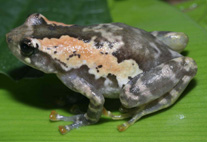Abstract
We provide a revision of microhylid treefrogs of the genus Cophyla, the type genus of the subfamily Cophylinae. A phylogeny inferred from DNA sequences of multiple mitochondrial and nuclear genes, with representatives of all cophyline genera except Madecassophryne and including representatives of the two most divergent intrageneric lineages within Cophyla, placed Cophyla as sister group of Platypelis and confirmed both genera as reciprocally monophyletic. We describe three new Cophyla species based on osteological, morphological and bioacoustic characters as well as genetic differentiation in one nuclear and several mitochondrial markers. As in the vast majority of cophylines, all species of Cophyla emit long, stereotyped repetitions of a single tonal note, and we here consider one of these notes as a call; call duration thus equals note duration and the intervals between calls are named inter-call intervals. Cophyla maharipeo sp. nov. collected in Joffreville and Forêt d’Ambre Special Reserve (adult SVL 22–27 mm) is characterized by having long calls (1166–1346 ms) with long inter-call intervals (2154–3881 ms). Cophyla noromalalae sp. nov. collected in Montagne d’Ambre National Park (adult SVL 22–29 mm) is characterized by having short calls (662–821 ms) and short inter-call intervals (874–1882 ms). Cophyla puellarum sp. nov., also from Montagne d’Ambre National Park, is larger than the other two species (adult SVL 27.3–33.6 mm) and characterized by the shortest calls (326–390 ms) and long inter-call intervals (1961–3996 ms). Osteological analyses based on micro-CT scans and cleared and stained specimens confirms that the shape of the posterior vomer (centrally divided vs. undivided) may be a useful character to diagnose most species as belonging to either Platypelis and Cophyla, and suggest the absence of clavicles (present in Platypelis) is a derived character of most Cophyla. However, clavicles were present in C. puellarum, the only known Cophyla occurring at relatively high elevations (1250–1300 m a.s.l.) while otherwise in northern Madagascar, forests at higher elevations up to 2700 m a.s.l. are occupied by Platypelis species. Cophyla maharipeo was found at relatively low elevations (630–720 m a.s.l.), similar to the three previously known congeners (C. berara, C. occultans, C. phyllodactyla). Cophyla noromalalae occurs at intermediate elevations (900–1050 m a.s.l.). The molecular phylogeny inferred herein suggests that the ancestor of a clade containing all Cophyla species except C. puellarum evolved a modified shoulder girdle structure without ossified clavicles, and adapted to low-elevation habitats.

